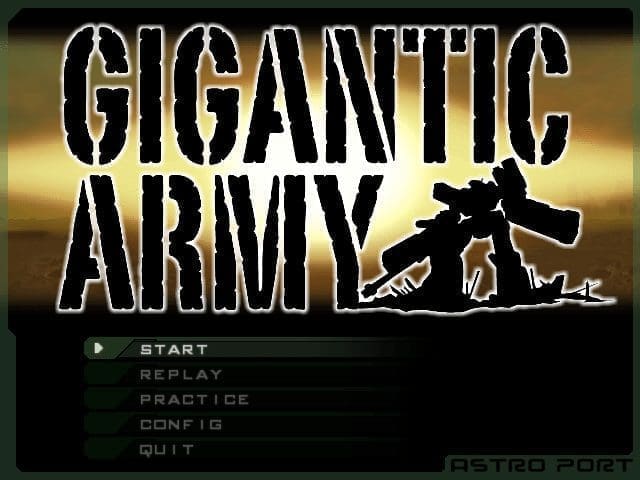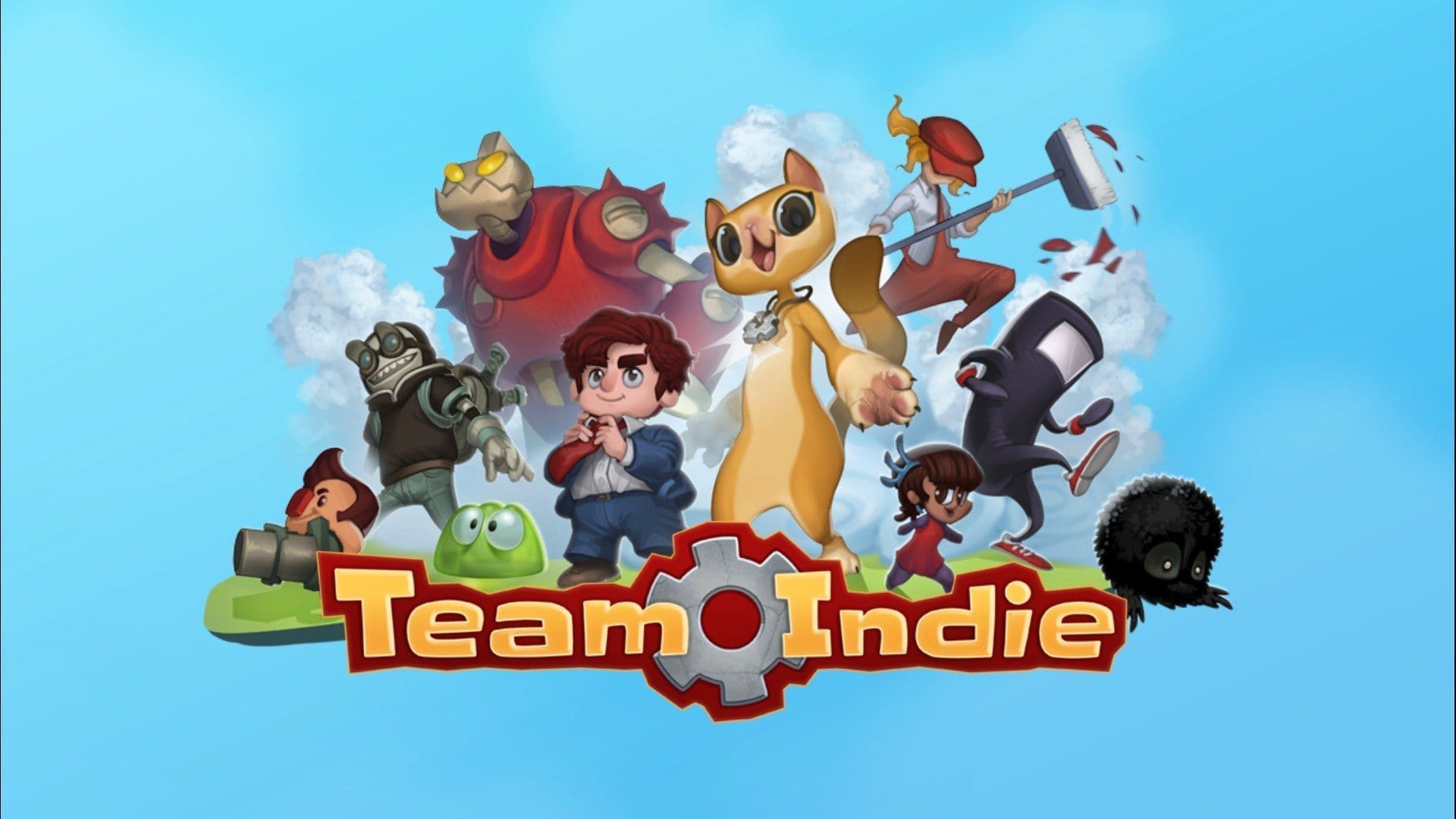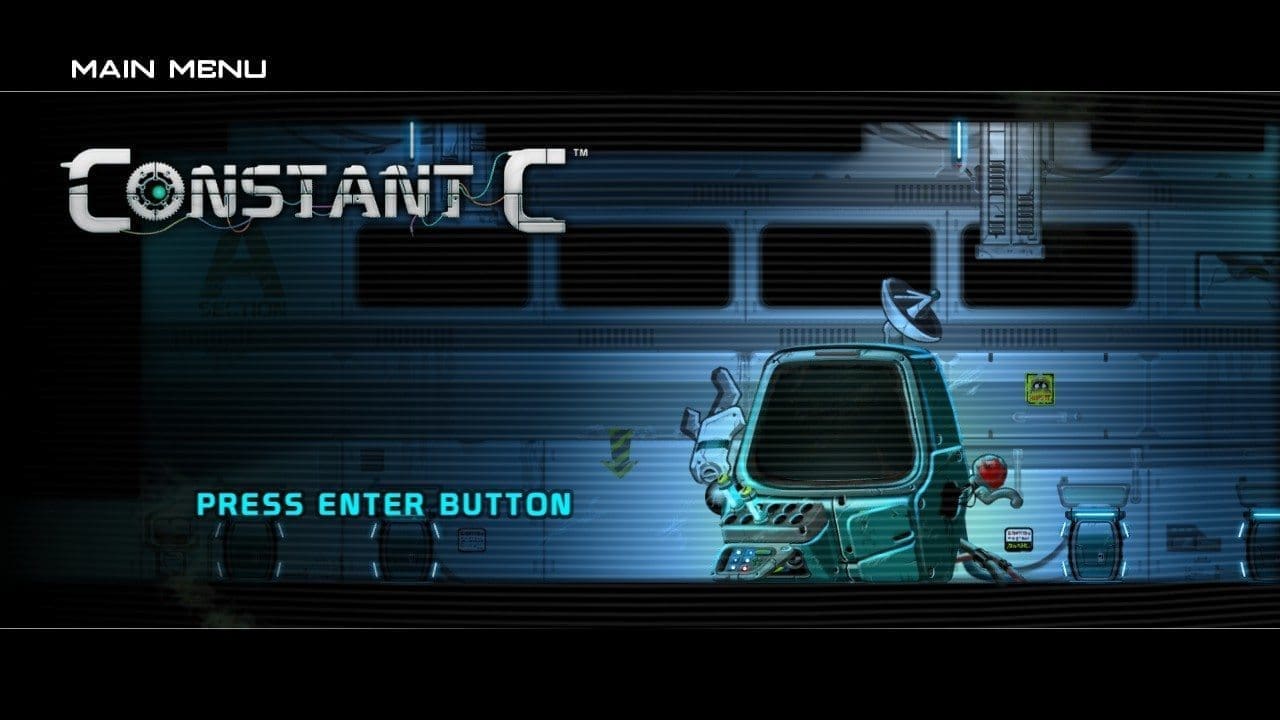Gigantic Army is a side-scrolling run-and-gun shoot ’em up set in a science fiction alternate present with giant robotic mech suits. What’s not to love about that premise? You pilot a massive piece of machinery through six chaotic levels reminiscent of the 16-bit era mech assault gems like Cybernator or Metal Warriors. If you haven’t played into the mech genre too far, it’s essentially your standard run-and-gun game like Contra 3, but with giant robots.
Gameplay
Gigantic Army throws you right into the fray of the final stages of a war between humans and Ramulons, an alien species who seems to have adopted giant robot fighting technology just like the humans did. That’s about as much of the story as you need to know, it’s not really the game’s strong point. Anyway, from the moment you start the game you will be shooting and slashing countless hordes of mechanical foes, both stationary and mobile. It’s not anything really groundbreaking, a few turrets here and there, some endlessly spawning fodder to mow down, and two ridiculously over-sized bosses per level. If you are looking for innovative gameplay, this isn’t your stop. Not that there’s anything wrong with that, the game is fun to play, but it is very much an homage to the games it draws its inspiration from. The biggest real change is the level timer, which honestly only came up about twice. It does help you streamline your play and focus on what’s important though, but a timer isn’t exactly groundbreaking.

Run, shoot, jump, occasionally dash, it’s all very simple. The levels are basic, with limited platforming and a heavy focus on combat. The enemy diversity is just where it needs to be; not so many that you can’t keep track and they all feel unique, but enough that they present a significant challenge and keep you on your toes. When you start the game you are given a choice between three different primary and secondary weapons, and that choice is set for that game. Since completing the game on normal only took me about 45 minutes when I finally was able to beat it, it’s not a very permanent decision, but it is a bit sad that you are stuck with really only two different ways of dealing with the enemies on a given attempt. Diversity isn’t exactly the focus of the game, there are no power-ups or combos or fancy special moves, just the two weapons you start with and a whole lot of metal between you and victory.
The lack of play variety would normally make a game feel very repetitive, but with short levels, frequent bosses and a good variety of enemies, it never really felt monotonous. After beating the game, I would have liked to have more options, different mechs or some more weapon layouts to choose from to give the game more life and replay value. Sadly, the few weapons that are available are very similar, and at least for me there was a clear “best” option, without which I wouldn’t have been able to complete the game. What the game focuses on though, it really does well; trudging through hordes of robots and blowing up everything in sight. It’s very satisfying to blow things up, and seeing the five-story-tall death machine collapse into a pile of rubble is just amazing. It’s not stale or boring, but it’s very heavily focused, so know what you are getting into.
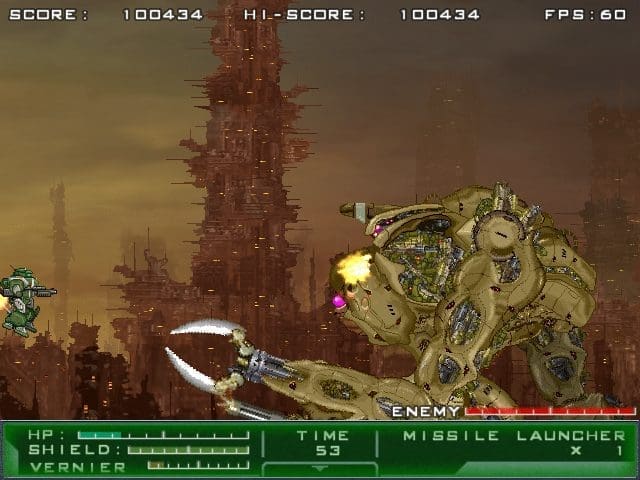
Interface
The heads-up display tells you everything you would ever want to know about the state of your game. It’s not amazing, but it never gets in the way; it’s functional. That is probably the best thing this game’s interface has going for it. The game offers gamepad support, but if you’re looking for a game to play with a controller in hand reclined in your chair, this isn’t that game. There are only five functions that can be mapped to the gamepad, and while that covers you for combat, it misses out on things like pausing the game or opening the menu. You can map the screenshot button to the gamepad though, so I guess go nuts there, but if you want to be able to actually play this game end to end, you are going to need to be at your keyboard at least part of the time.
There are two control systems that this game really could do with improving upon, and those are the aiming mechanism and dashing. You can use the up and down arrow keys to tilt your mech’s gun to shoot down hills or up at flying enemies or mounted turrets. You can also level your gun dead ahead by holding left or right. You may have already picked up on the problem this creates, you can’t walk and aim at the same time. Fortunately, while you are firing your primary weapon, your gun stays aimed right where you left it no matter what you press. This causes another problem, which is that you can’t shoot and aim at the same time. Getting used to this system takes a lot of practice, and is the primary reason it took me three attempts to beat the game.
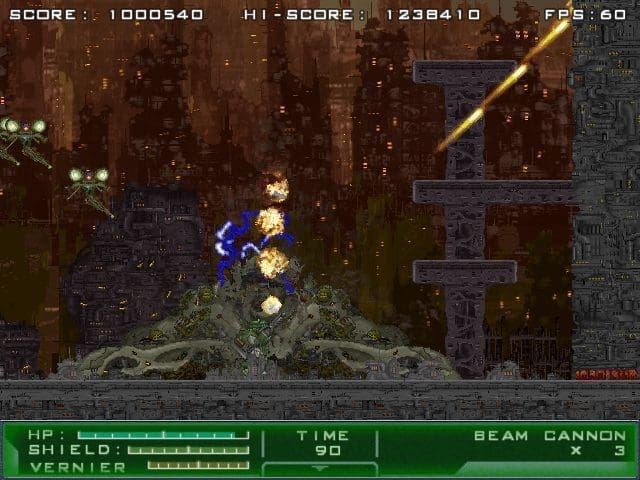
After playing for long enough, you eventually get the hang of stopping and letting go of the fire button to aim and then quickly firing and moving again. It’s awkward, but you can master it. The dashing though, I never figured that out. One of the few things that still baffles me about interface design to this day is the double-tap action. Double-tap right to dash right, it seems so simple. I apparently have the manual dexterity of a fish flopping around on a keyboard though, because more often than not I would either dash unintentionally or stop dead in my tracks when I wanted to dash. A dash button would go a long way in smoothing out the play and making it easier to dodge. It’s like the game’s shield mechanic, eventually I just stopped trying to use it and was better off for it. Maybe on the harder difficulties you need to master it, but thankfully just to beat normal you can wholly ignore it.
Visuals
I have been resisting the urge to talk about graphics from the start of this article. The graphics on the whole are good. The mech sprites animate well, the pixel art isn’t focused on looking retro, it just looks good. The backgrounds have a nice parallax effect, the foreground clear and makes it easy to tell where you can go, and the intricate circuitry exposed throughout the game is nothing short of impressive. Each of the mechs look distinct and are easy to identify, and the bosses are both massive and finely detailed. At no point in the game did the environments, enemies or even the flurry of projectiles on the screen become repetitive. That’s all well and good, but that’s far from the best part.

Watching the non-stop barrage of explosions in this game made me feel like a little kid again. Every thing blows up, and they all do it spectacularly. They don’t get old, either. There are unique explosion graphics for just about everything. The grenade launcher explodes differently than the missiles, which are different from the enemy mechs, and on and on. I actually spent a good five minutes poring over screenshots of various boss explosions to pick one to use in this article. There were many, and they were all awesome.
Audio
For the most part the audio in this game fits very well. The background music for most of the game is spot on; foreboding in between levels, fast paced during the action, and somber when you inevitably die. It’s a bit repetitive, but the game is short and the music changes so frequently that you hardly notice it. The screens in between levels where the story text is written out actually have no music, which just reinforces my theory that the story was slapped on last minute. The sound effects are equally effective, though they don’t really stand out. Explosions sound like explosions, the mechanical sounds of the various robots all do a good job immersing you in this metal universe. The actual sounds and music are good, but not amazing. Their effective use, however, is what really stands out.
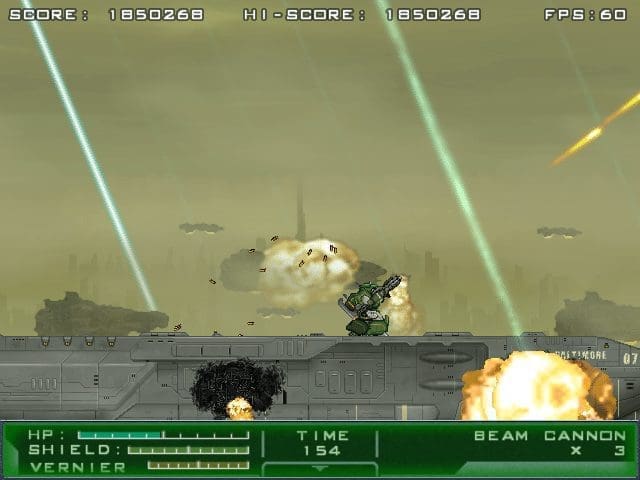
This game does a very good job painting a picture with sound effects. When you walk, it really sounds like a huge piece of machinery lumbering about. When you land, the echoing thud sounds exactly like you expect a falling 20-ton machine to. The various creaks, pings, and crunches give you a wonderful sense that you really are out there in the middle of a frantic war. Big attacks have charge up sounds that give you plenty of time to react, and the deflection and damage sounds make it very obvious that you are hitting the right spot, which is especially useful when the boss you are fighting is three screens tall. I already gushed about them for a whole paragraph, so I’ll be brief here, but the explosions sound just as good as the look.
Conclusion
There are two things that I generally look for in an indie game, innovation and focus. While it falls flat on the innovation front, it really nails the focus concept. This game is about one thing, blowing up robots from inside of a giant mech suit. Everything in this game exists to support that endeavor, and it really works. There are some hiccups with the controls, and the story is just as tacked-on as anything out of the 16-bit era action genre, but if you want to blow things up, the guys at Astro Port have got you covered. Mech fans and run-and-gun fans will both likely get a lot out of it, but the unwieldy control scheme might be too much for your average gamer. At $6, it’s a bit high for the two hours an average gamer will get out of it, but if you are going to go all in and beat it on insane mode, it’s worth every penny. The game was just picked up on Steam’s greenlight, but you can head over to the Gigantic Army site to pick it up now and you’ll get a steam key when it comes out there as well.
[SlideDeck2 id=9271]
Ever since smashing my first goomba at four years old, I've been a video game fanatic. I grew up with games, and when the big studios started pumping out the same games over and over again, I turned my eye to where the real fun is. I haven't bought a game from a major publisher in years, and I want to share my love for the indie gaming community with you all. When I'm not playing or writing about indie games, I'm out there trying to make my own. Hit me up on twitter, @empyrealhell, for the latest look into this small but wonderful slice of gaming.


















